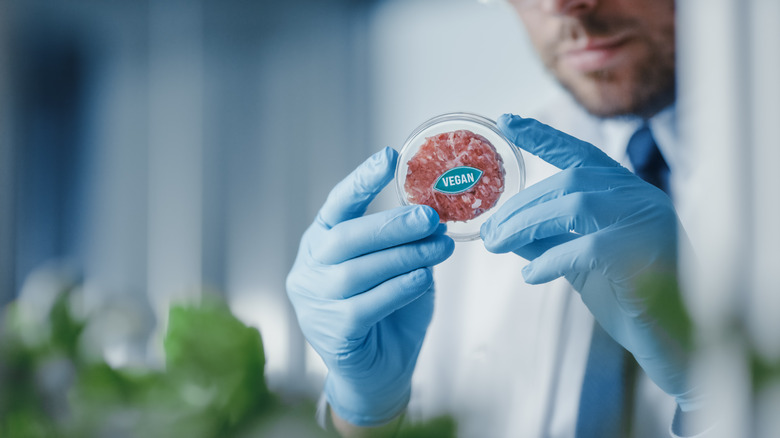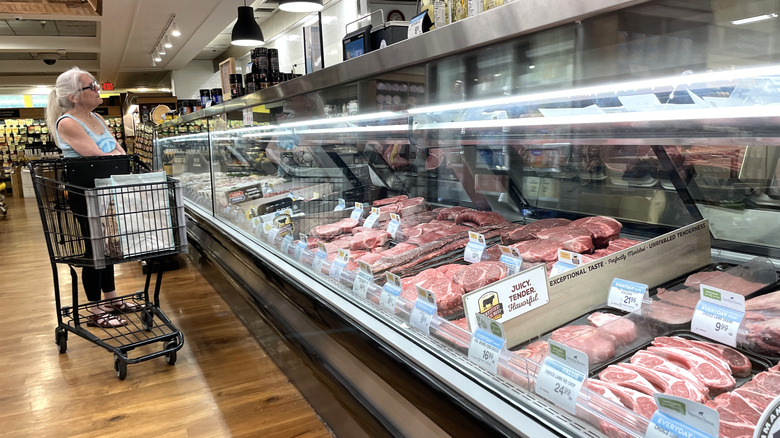How SuperMeat Is Trying To Change The Way Cultivated Meat Is Produced
In today's supermarkets, plant-based meat brands line refrigerator aisles. According to the Plant Based Foods Association, the U.S. retail sales of plant-based foods increased by 6.2% to a record high of $7.4 billion last year — and that's on top of an all-time high growth rate in 2020. Folks opt for plant-based meat alternatives for any number of reasons, including sustainability, dietary preferences, health needs, religious practices, or vegan lifestyles. However, it's no secret that many of these meat alternatives fall flat with consumers; the mouthfeel and flavor of meatless meat crafted from chickpeas and soy protein often come up short of the real thing. Now, thanks to cultivated meat company SuperMeat, meatless consumers might not have to sacrifice that authentic meat-eating experience.
Here's how it works: SuperMeat starts with embryonic chicken stem cells and processes them into lab-grown chicken meat with an animal-free growth serum, according to European news outlet Sifted. To simplify the meat-cultivation process even further, SuperMeat grows these embryonic cells in fermentation tanks (like the ones used in breweries) where they are fed with growth serum and incubated to multiply and mature, per FoodNavigator USA. SuperMeat, Sifted says, uses stem cells from Label Rouge chickens, a gourmet breed in France — which means better quality and a higher price point. However, the stem cells themselves are actually not even the most expensive part of the meat-cultivating process — and SuperMeat is working to develop new technology that would eliminate these high production costs altogether.
SuperMeat is working to lower the cost of cultivated meat production
According to SuperMeat CEO Ido Savir, the priciest component in making lab-cultivated meat is the cell-growth serum. Savir told Food Dive, "You can ask anyone who is in biotech or anything related to cells: the cells that we're using... are very early embryonic stem cells. These are the hardest to grow and the hardest to maintain and use in terms of production."
To offset the cost of production, SuperMeat is launching a movement to lower the price of this special cell-growth serum, which accounts for a large part of the reason making lab-cultivated meat is such an expensive process, in the first place. Savir told VegNews, "The entire cultivated meat industry is at the stage of demonstrating that cultivated meat manufacturing is viable on a commercial scale — and that the demand exists from consumers to do so."
In a March press release, SuperMeat announced that it would be partnering with food biotechnology company Ajinomoto to formulate more cost-effective cell growth materials. If successful, this development would make cultivated meat marginally more accessible to the modern consumer grocery market. Step aside, corn sausages.
The future of the meat industry
The ultimate goal of these innovations is to make cultivated meat such a cost-effective industry that it totally undercuts the efficiency (or lack thereof) of traditional meat agriculture altogether. SuperMeat itself says that its mission, with these new innovations for cost-efficiency in play, cultivated meat technology could reduce food insecurity, lower carbon emissions, and provide a sustainable and animal-friendly process for bringing real chicken to the consumer market. SuperMeat is looking to start selling its lab-grown products in the U.S. by 2023 (via VegNews) and has its eye on a U.S. manufacturing facility too, per Food Dive.
From an industry perspective, Savir explains that fluctuating consumer demand can also be met with this new technology. During periods of high demand, like around Thanksgiving or Christmas, cultivators can preemptively increase supply production in preparation — a much more efficient method than the seasonal scarcity and subsequent price increase of the traditional meat market around the holidays, per VegNews. If it is able to develop this cost-effective cell-growth medium, SuperMeat hinted at making the formula available to other manufacturers of lab-grown meat in order to help put cultivated-eat on the map, per Food Dive. The future of alternative meat options might be closer, more real, and more affordable than ever before.


